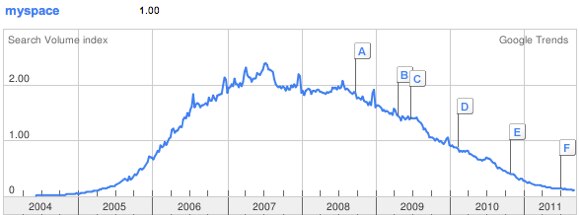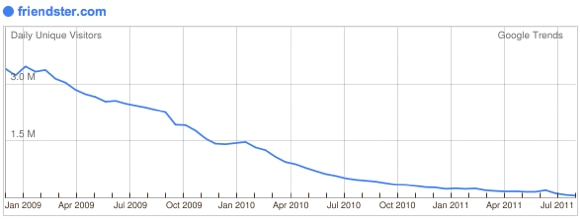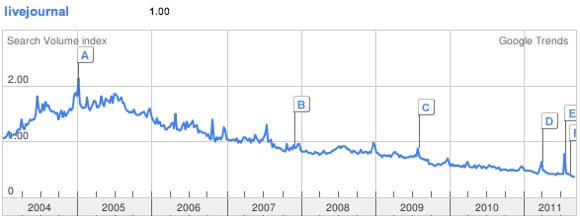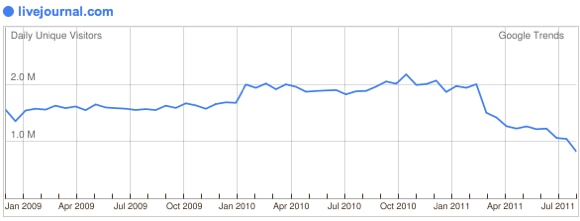
The current big international social networks are Facebook, Twitter, LinkedIn and the newly formed Google+, and perhaps Tumblr, if you choose to look at it as a social network. However, go back to around 2004-2005 and these were either not around yet, or just taking their early baby steps. Back then the big ones were Friendster, LiveJournal and MySpace.
And we’re talking in past tense, because oh how the mighty have fallen. Web users are a fickle bunch, and there is probably no market as trend sensitive as social networking.
How bad is it? As you’ll see, they’re all caught in a downward spiral, but they might have peaked later in life than you think.
MySpace
 Started in 2003, MySpace was the big dog before Facebook stole its thunder. It was a pretty strong player until quite recently, especially in the United States.
Started in 2003, MySpace was the big dog before Facebook stole its thunder. It was a pretty strong player until quite recently, especially in the United States.
At its peak in 2007-2008, the then News Corp-owned MySpace was valued at $12 billion. In June this year, News Corp. sold MySpace for $35 million and a 5% stake in the new owner, Specific Media.
Worldwide interest in MySpace, 2004 – today:

Worldwide site traffic to Myspace, 2009 – today:

(There’s more information over at Wikipedia, if you want to read up on MySpace’s history.)
Friendster
![]() Started in 2002, Friendster quickly became a huge success (it’s the site that inspired MySpace) and pretty much became a blueprint for the modern-day social network. It went from being popular everywhere, to mostly being used in Asia, especially SE Asia, which has remained its power base.
Started in 2002, Friendster quickly became a huge success (it’s the site that inspired MySpace) and pretty much became a blueprint for the modern-day social network. It went from being popular everywhere, to mostly being used in Asia, especially SE Asia, which has remained its power base.
In May this year, Friendster pretty much committed harakiri – at least as a social network – and was completely redesigned to focus on social gaming.
Worldwide interest in Friendster, 2004 – today:

Worldwide site traffic to Friendster, 2009 – today:

(You can read more about Friendster’s history over at Wikipedia.)
LiveJournal
 Started in 1999, LiveJournal is a blogging service with strong social elements. In many ways it’s one of the social networking pioneers. To give you an idea of its status, early in the movie The Social Network, Mark Zuckerberg (as played by Jesse Eisenberg) is seen blogging on LiveJournal. The scene takes place in 2003.
Started in 1999, LiveJournal is a blogging service with strong social elements. In many ways it’s one of the social networking pioneers. To give you an idea of its status, early in the movie The Social Network, Mark Zuckerberg (as played by Jesse Eisenberg) is seen blogging on LiveJournal. The scene takes place in 2003.
In 2009, after having been bought by a Russian company (SUP) a couple of years earlier, the operation of LiveJournal was moved from the United States to Russia.
Worldwide interest in LiveJournal, 2004 – today:

Worldwide site traffic to Livejournal, 2009 – today:

(More about LiveJournal’s history over at Wikipedia.)
“Hold on, we’re not dead yet!”
The funny thing is, relatively speaking these social networks are still big. They still have millions of users. They haven’t died, they’ve just fallen from grace, most of their users having left for greener pastures.
It’s like one of those aging Hollywood movie stars of yesteryear, still good, but no longer cast in the best roles and no longer able to pull the crowds to the theaters.
“I used to be famous,” she said with a sigh. “I used to be a star.”



























